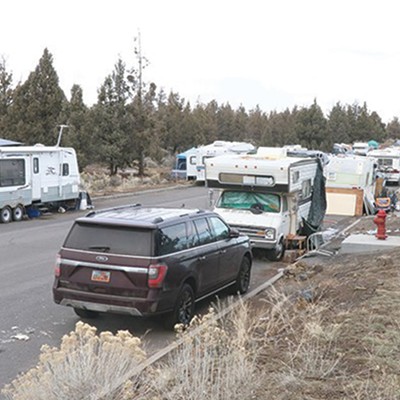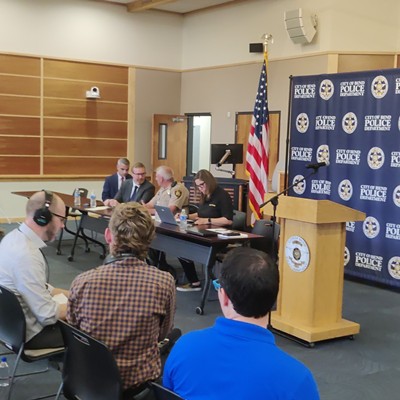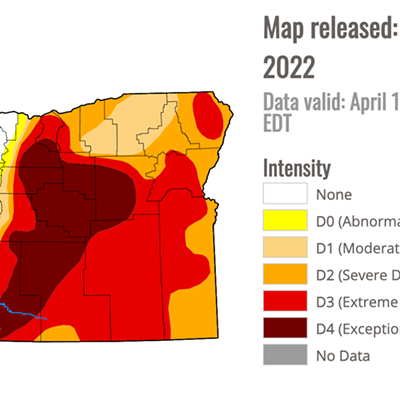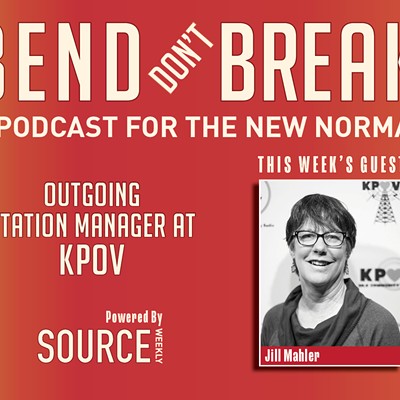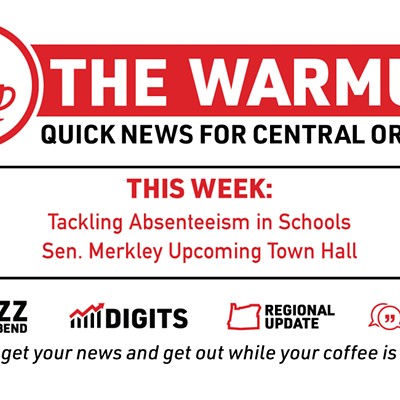La Pine junior Zoey James mustered her social energy and drove with her sister Camille through the snow to a party being thrown by a classmate. A stereotypical rural teen scene ensued: Cheap liquor. Hip-hop beats. Dizzying grinds on the dance floor. Only a few sips into a vodka drink, the room started to spin for Zoey, too.
Then, Zoey realized her sister had disappeared. She staggered upstairs in a drug-laced stupor and found Camille passed out and naked on a bed. Unable to stand, Zoey felt herself collapse next to Camille. Hours later, Zoey awoke. Now, both she and her sister lay naked, their bodies covered with Sharpie-drawn obscenities and crude pictures. As quickly as possible, Zoey fled the scene with her sister, ashamed and scared as they drove back to their trailer home and mother. Then, the texts came.
"Ur sister is hot." A Snapchat picture showed Camille naked on the bed.
"Ur even hotter." Then, a picture of Zoey.
"If u tell ur mom about the pics, I'll beat ur sister."
Text threats were just the beginning. What followed became a living nightmare of sexploitation in rural Central Oregon for the two socially vulnerable teen girls. A web of fear first cloaked in feigned adoration ultimately coerced them into a ring of paid sex acts, pimps and powerlessness.
Zoey and Camille are not real. They're characters in a just-released novel by author Chris Stollar called "The Black Lens." Written by the previous Bend resident and Bulletin news reporter with Central Oregon as a backdrop, "The Black Lens"; reminds us that human trafficking, sex slavery and exploitation are real. For many young people in Central Oregon, the world of sex trafficking is non-fiction.
"I first heard about sex trafficking soon after I started working as a news reporter in Bend for The Bulletin," explained Stollar. "Some of my sources kept encouraging me to investigate a truck stop in La Pine that they claimed was being used as a hub for trafficking. It started a decade-long quest to research and write about this issue."
Stollar's recent novel focuses a lens on a burning question:
Just how much sex trafficking truly exists in Central Oregon?
Defined as sexual activity involving a child in exchange for something of value, CSEC (Commercial Sexual Exploitation of Children), or "sex trafficking," has entered the American vernacular. National and local statistics frame the issue:
Globally, the International Labor Organization estimates that there are 4.5 million people trapped in forced sexual exploitation globally.
In a 2014 report, the Urban Institute estimated that the underground sex economy ranged from $39.9 million in Denver, to $290 million in Atlanta.
In 2015, Cascade Youth and Family Services reported serving 498 homeless, runaway and street youth. According to the National Center for Missing & Exploited Children, an estimated 1 in 6 endangered runaways reported were likely sex trafficking victims. CYFS served 101 runaways. Doing the math, that's potentially 16 victims at one shelter alone.
"We've had girls...and boys...self-report for years that they've traded their body to survive on the street," said Melissa Parker, Project Manager for Cascade Youth and Family Center, and part of Central Oregon's CSEC Response Team that combats sex trafficking locally. The team is comprised of the City of Bend Police, FBI, Deschutes County District Attorney and numerous shelters and advocacy groups. "Now we call it something different. If I perform oral sex and somebody else is profiting from it, that's commercial sex. There's a third party involved. I don't think it is a newer development."
What has shifted, Parker and others on the team note, is the extent and nature of sex trafficking.
Sex Sells and Sells: Machiavellian Renewable Commodity
"It used to be that guys were trafficking drugs, but drugs are a commodity that you can get caught with," said Stephanie Alvstad, Executive Director of J Bar J Youth Services in Bend. "When you're trafficking girls, it's pretty lucrative because you sell it, and you turn it around, and you sell it again and again. It's an awful concept, but they're 'reusable.' More and more of the nefarious crowd are getting into that because it's pretty easy to make money," Alvstad said.
"Sex is a currency that's renewable, it never runs out," echoed Parker. "Girls can be sold multiple times a night."
Because sex sells more than once, trafficking activities have adapted to capitalize on this renewable resource. Victims ensnared in this Machiavellian scenario are either part of a local ring or on the move through a major travel corridor, explained Jeff Keith, another member of COCSEC and founder of The Guardian Group. Working with ex-CIA and military personnel, his Central Oregon nonprofit operates much like military Special Forces, using grassroots tactics to track and identify sex traffickers and their victims in major Western cities.
The Opportunity Highway
To maximize profits, the sex trafficking industry has hit the road, says Keith, utilizing known drug trafficking routes to move human cargo between cities, orchestrating commercial sex hookups along the way.
Keith noted, "The Mexican [drug] cartel was driving things up 97 and dropping things in Terrebonne. If the drug route is there, you're going to have a people route, too. You have this young group of kids that are here, and this demand from men who are coming into town for business, activities and recreation. What we're doing is bookending the I-5 corridor. Seattle, Portland, Northern California, Southern California...because we're starting to see [trafficking] happening here."
Keith said that sex trafficking presents many parallels to modern terrorism—nimble, elusive rings with distinct hierarchies of power and devotional loyalty in exchange for protection and honor. A victim's promise of being valued and cared for fosters a deep sense of belonging that creates a built-in protection system for kingpin sex traffickers. It also leads to a low level of self-reporting by victims, who often won't reveal the identity or activities of their gatekeepers: the pimps. To infiltrate these rings that hide amid the technology and local ether, Keith said it takes an on-the-ground, multi-faceted and collaborative approach to identify pimps and bust sex trafficking rings.
"Girls can get hooked into trafficking from the local scene, but creating a web of advocacy is also a catch-point nationally [in order to] catch a trafficking phenomenon that is always on the move," Keith argues. "Girls can spend just one night in Bend, and be in Las Vegas the next. Then Seattle. The emphasis is on education for identification and advocacy."
Girl Power: The Grooming Process
Understanding how this high-profit, opportunistic culture of commodity can target and exploit vulnerable youth, then, becomes critical, advocates like Parker say.
Parker, who has worked with J Bar J homeless and runaway youth since 1998, passionately related how she has learned firsthand how victims of sex trafficking become trapped due to their social and emotional vulnerabilities. Adolescents are inherently prone to seeking approval, value and acceptance, she said. Those disenfranchised from parents due to alcohol, divorce, step-parenting or abuse are at risk of getting into "the life" even though they don't mean to.
"Your adolescent brain puts you at risk. If someone's going to tell me I'm smart and beautiful and capable of doing lots bigger things than living at home and doing 'boring' things. I want to hear that," she explained. "They're not prostituting themselves. They've been sold. Their self-esteem is tied to it. Their identity is tied to it."
"[Victims] don't actually know it's happening until it's happening," said Alvstad.
"The girls are making money, but they're giving it to the pimps, [who buy] them all sorts of things. They get nice clothes, the drugs they want...it's an interesting phenomenon."
Kissy Face
In addition to psycho-social factors, prolific technology serves as a stealthy tool used to coerce and manipulate victims into a life of sexual exploitation, Parker and Keith said.
Keith, whose organization pores over sites like Facebook, Instagram, Snapchat and Twitter to track trafficking activity, said recruitment happens largely on social media. This allows pimps to recruit and operate in a virtual world hidden from the public eye.
"Grooming happens at different levels," explained Parker. "It's not like the head dude's walking into the school saying, 'Come on, girls!' It's not the classic pimp picture." She added that often girls who post age-appropriate selfies to attract attention make themselves vulnerable to social media recruitment. "[Then], little by little, there's an indoctrination and desensitization to the point where they [the pimps] say, 'You do me this favor because you love me, right?'"
Keith adds, "When they've got the girl either emotionally or physically, then they actually have to sell the girl. [Often] that happens online."
This April, David Cobbs, 35, was arrested locally for sex trafficking, and he's not the first. Since January 2015, officials have made nine other arrests for prostitution and trafficking-related crimes, according to Deschutes County District Attorney records. Keith explained how local rings, like the one Cobbs was in, feed into a larger trafficking network.
"King David [Cobbs] comes up every month out of LA—Seattle, Portland, Bend. He has a handler in every town, and connects those handlers with the girls. They meet at a hotel and they bounce and within two days she's on Backpage," Keith said.
Not in My Backyard?
The statistics and signs are there, yet for many communities, skepticism remains when it comes to believing sex trafficking is a local problem. Is this happening? Worsening? Or, is this issue a matter of smoke and mirrors?
Keith and others say focusing on reporting numbers as an indicator of the problem can be misleading due to the complex psycho-social dynamics inherent to sex trafficking. Cases locally continue to occur.
"Since April, and the King David case, there's probably been four," Keith shared. "There was a girl who got booked into juvenile detention, and she said, 'I'm a victim of trafficking.' She's opened the door to [so many more.] This informant we've got has listed five others where we know these girls are victims."
J Bar J's Alvstad said, "It's just happening more and more. We're hearing about it. We have three girls in our shelter that have been trafficked. They don't always self-identify as victims, which is the hard part."
"It's like expecting all the wives of abusive husbands to come forward," explained Keith, who said he sees about one case of sex trafficking locally every two weeks. After his interview, he called back to say he'd just received a call about another.
Pimps in Pleasantville: Trifecta for Small Town Sex Trafficking
Despite evidence that sex trafficking is on the move through Central Oregon, Keith and Parker concur that much of the community remains unaware or struggles to accept that it could be happening here.
"We are viewed as Pleasantville. So, it's the perfect place to do any crime," said Parker. "We're walking by people and not thinking we have sex trafficking because we don't want to."
"Anytime you have a place with men and money, the homeless at risk population and the Internet, it's a trifecta for it happening here. And it's off the grid," Keith said. "When Chris, [Detective Morin, City of Bend Police] did a Backpage sting, it was local men, too. Doctors, lawyers, roofers."
According to Keith, some community members remain resistant to acknowledging the local existence of sex trafficking. "When you try to get people to understand the problem, most of the time it's almost like they go through the stages of death. They deny it. Before acceptance they get angry. There are few you can get to say, 'Yeah, let's do something about this,' because they don't want to believe it. It's a huge paradigm shift and they can't handle it. The reality is that it's happening in every city."
Keith believes the slow acceptance is also because, "It hits them economically, financially as well. People in this community who make money don't want to talk about it because this community is viewed as safe."
Proactive Prevention
Ultimately, the goal of the Response Team and its players is not to instill fear, and to be proactive rather than reactive.
"I think information is important," Parker explained. "When you're educated about real things and you have true knowledge, you're safer. We're not trying to scare people, and [these efforts] in our community seek to eradicate it."
"Everything that's come out, the majority of what's come out [about sex trafficking] is scare tactics," Keith reflects. "People end up having compassion fatigue. People think, 'Another thing? What can I do about this?' versus being proactive and inspirational, saying we're not going to let it happen in our community. Our community can do something about [this]. Let's go after this problem and let's do it with people, together."
Next month, J Bar J is submitting a Street Outreach Federal Grant to The Family Youth Service Bureau. This grant will fund the Street Outreach program—providing workers on the street to build trust, provide resources, and reduce the risk of trafficking.
Resources
National Human Trafficking Resource Center: www.polaris.com
Human Trafficking Hotline: 1-888-373-7888
Cascade Youth and Family Center: www.cascadeyouthandfamilycenter.org
The Guardian Group: www.theguardiangroup.org
The Black Lens book and advocacy: www.christopherstollar.com



